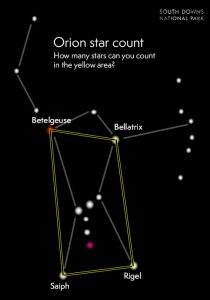Help us count the stars
January 8, 2018
Ahead of our second South Downs Dark Skies Festival this February we need your help to measure how our dark night skies are changing by counting the number of stars you can see in Orion.
Words by ‘Dark Skies’ Dan Oakley
Looking up on a clear night can you see the Milky Way or the Andromeda galaxy? What you’re able to spot with the naked eye will depend on the darkness of the sky above you. To prove that the South Downs’ was worthy of International Dark Sky Reserve (IDSR) status we had to take more than 25,000 measurements of sky quality over three years.
But our work doesn’t stop there. In order to protect our night skies we need to measure whether their quality is staying the same or changing over time – this is a big job so we really need your help.
 It’s very simple to get involved. Start by choosing a safe place to look at the stars and wrapping up warm – ideally you need to be away from direct lights like street lights or your phone for 20 minutes to make sure that your eyes are fully adjusted. Orion will rise from the South during the winter and one of the easiest ways to find him is to look for the row of three stars in his belt. Now imagine a wonky rectangle from his shoulders to his feet and count all the stars in this area – including the three bright stars in his belt.
It’s very simple to get involved. Start by choosing a safe place to look at the stars and wrapping up warm – ideally you need to be away from direct lights like street lights or your phone for 20 minutes to make sure that your eyes are fully adjusted. Orion will rise from the South during the winter and one of the easiest ways to find him is to look for the row of three stars in his belt. Now imagine a wonky rectangle from his shoulders to his feet and count all the stars in this area – including the three bright stars in his belt.
How many did you find? If you were in the darkest skies in the world you might see 40. In towns and cities with lots of light pollution you should have spotted between 7 and 10. If you’re further into the countryside you might see between 15 and 25. If you’re in the very darkest parts of the South Downs National Park you’ll see between 25 and 32.
Good luck and remember to #embracethedarkness!
Tell us how many stars you found and where you counted them at www.surveymonkey.co.uk/r/Orion-2018
The South Downs Dark Skies Festival runs from 9 to 25 February 2018. Find out more
